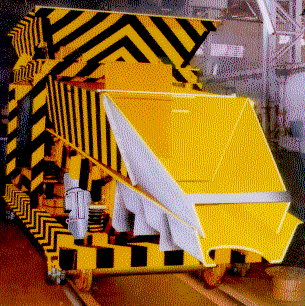Vibratory Furnace Charging Device

The demand for high quality foundry products and their cost effective production places high demands for furnace charging equipments in melting plants. Though much of the initial head way made in foundry automation was with the mould making process, more important is the meltshop automation. This includes remote furnace charging systems. Automation is mainly thought of as a solution to high labour cost and it certainly can increase workers productivity. However, much more important today is the effect of automation on quality. Another important advantage that automation provides in foundry environment is enhanced safety. For example automation allows foundrymen to work at a safe distance from molten metal or do their jobs behind protective barriers thus reducing injuries from metal splash or furnace eruption. Also where automation exercises monitoring & control functions, it helps prevent accidents related to in-attention or judgement errors.
Today's most technologically advanced induction furnaces provide high power densities and are able to run to full power throughout the charging process. These furnace require rapid charging to keep pace with the melting power of the system. In many foundries, however, charging the furnace can be a labour-intensive.Moreover, manual operation is too slow which does not allow maximum utilization of the melting system. Charge materials are simply dumped into the furnace with wheel barrows or dropped in by hand essentially the same way as it has been done for centuries. Besides the inefficient use of time and manpower, manual charging can damage furnace lining if heavy charge materials are dropped into the furnace, thus gouging or cracking the wall or bottom refractory. In induction Furnaces improper manual charging can also lead to dangerous bridging situation in which tangled pieces of scrap from a layer above and apart from the molten bath. If unrecognised by the furnace operator, bridging can lead to superheating of the bath, failure of the furnace lining and runout.
Manual charging also directly exposes melt deck workers to the dangers of metal splash from charge materials hitting the molten bath and of furnace eruption or exoplosion caused by wet or damp chargematerials. Metal splash is one of the most common melt deck hazards & ideally, melt deck worker should be away from the furnace or behind protective barriers during charging which can only be accomplished with remote systems. Remote charging systems enhance safety not only by allowing melt deck worker to be away from the furnace during charging, but by reducing the chances of damage to the furnace lining & the likelihood of bridging situtation.
Vibratory Furnace Charger consists of a vibrating feeder mounted on a moving trolley with a storage hopper mounted above the feeder. The metallic components like scrap, bales, pig iron and foundry retains are stored in the hopper. The hopper shape is specially designed to enable bulky and irregular scrap pieces to be extracted without problem. The withdrawal of the scrap from the hopper is carried out by a specially built vibrating feeder. The feeder design is such that the materials conveyed are spread out into individual pieces as they flow toward the feeder discharge.
This technique brings about a greater accuracy of dispensing. The metallic components are dosed either into a weigh hopper or directly into the charge bucket whicch stands on loadcells or by lifiting magnet on crane hook with digital weigh scale.
The charging car on the vibrating furnace charger comprises a discharge chute with vibratory feeder for the metallic components and s hopper all mounted on the travelling framework with drive gear. The discharge snout is inclined and formed of a rounded trough to bring about a good charge distribution and enable irregular or bulky pieces of scrap or returns to be discharged. The feeder is driven by unbalancedmotors. The vibration frequency can be altered by an A. C. Inverter, thereby regulating the feed velocity and also influencing the noise emission. The batch hopper as well as the charging feeder is built in sandwich construction which reduces the noise generated by contact between the charge materials and the hopper walls or feeder deck. However, this does not eliminate the noise produced by contact between the charge pieces themselves.
Once the charge is prepared it is put into the storage hopper of the travelling charger. The charger drives from the loading point onto the furnace platform in front of the induction furnace. The furnace hood is arranged in such a way that it can be fitted for charging pouring. The furnace lid itself hangs from a chain inside the hood. The hood is raised and the charging machine drives upto the charging point and than the vibrating feeder is energised, The furnace is filled and as the contents are melted down the furnace is kept full.
Various logic circuits can be designed depending on the customers requirements so as to charge multiple furnaces using a single furnace charging device.The system can also be designed so as to achieve a completely automatic cycle with time lags provided for energising and de-energising the vibrating feeder and also for providing time lag for the reversing cycle.

